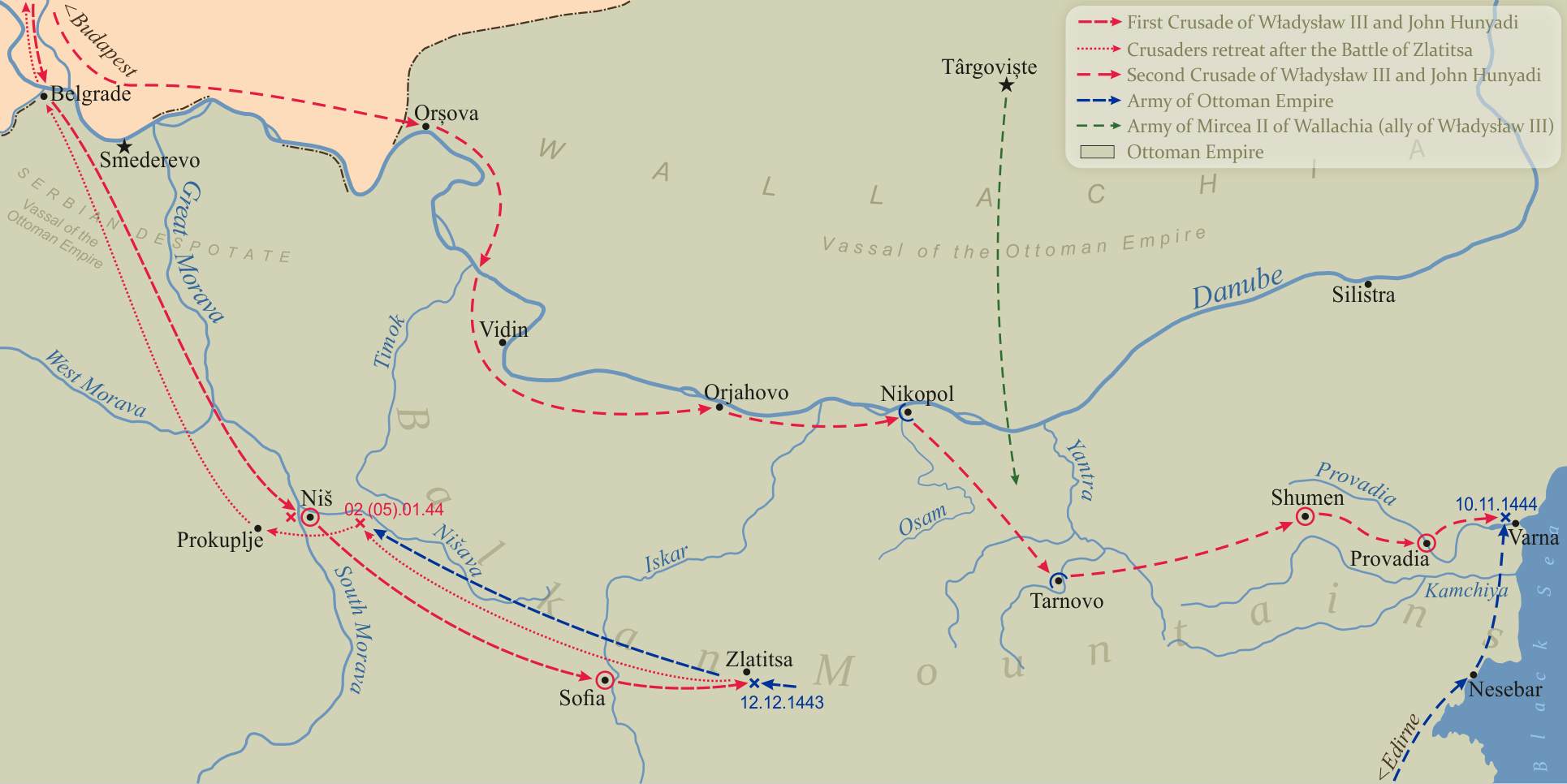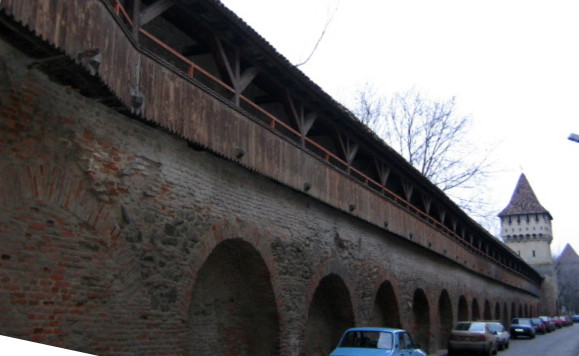|
Battle Of Zlatitsa
The Battle of Zlatitsa was fought on 12 December 1443 between the Ottoman Empire and Serbian and Hungarian troops in the Balkans as part of the larger Crusade of Varna. The battle was fought at Zlatitsa Pass () () near the town of Zlatitsa in the Balkan Mountains, Ottoman Empire (modern-day Bulgaria). The impatience of the King of Poland and the severity of the winter then compelled John Hunyadi to return home in February 1444, but not before he had utterly broken the Sultan's power in Bosnia, Herzegovina, Serbia, Bulgaria, and Albania. Background In 1440, John Hunyadi became the trusted adviser and most highly regarded soldier of King Władysław III of Poland. Hunyadi was rewarded with the captaincy of the fortress of Belgrade and was put in charge of military operations against the Ottomans. Władysław recognized Hunyadi's merits by granting him estates in Eastern Hungary. Hunyadi soon showed and displayed extraordinary capacity in marshaling its defenses with the limited ... [...More Info...] [...Related Items...] OR: [Wikipedia] [Google] [Baidu] |
Crusade Of Varna
The Crusade of Varna was an unsuccessful military campaign mounted by several European leaders to check the expansion of the Ottoman Empire into Central Europe, specifically the Balkans between 1443 and 1444. It was called by Pope Eugene IV on 1 January 1443 and led by King Władysław III of Poland, John Hunyadi, Voivode of Transylvania, and Duke Philip the Good of Burgundy. The Crusade of Varna culminated in a decisive Ottoman victory over the crusader alliance at the Battle of Varna on 10 November 1444, during which Władysław and the expedition's papal legate Julian Cesarini were killed. Background In 1428, while the Ottoman Empire was fighting a war with the Republic of Venice and the Kingdom of Hungary they achieved a temporary peace by establishing the Serbian Despotate as a buffer state. After the war ended in 1430, the Ottomans returned to their earlier objective of controlling all lands south of the Danube. In 1432, Sultan Murad II began raiding into Tra ... [...More Info...] [...Related Items...] OR: [Wikipedia] [Google] [Baidu] |
Turahan Bey
Turahan Bey or Turakhan Beg (; ; ;PLP 29165 died in 1456) was a prominent Ottoman Turkish military commander and governor of Thessaly from 1423 until his death in 1456. He participated in many Ottoman campaigns of the second quarter of the 15th century, fighting against the Byzantines as well as against the Crusade of Varna. His repeated raids into the Morea transformed the local Byzantine despotate into an Ottoman dependency and opened the way for its conquest. At the same time, his administration of Thessaly, where he settled new peoples, founded the town of Tyrnavos and revitalized the economy, set the groundwork for Ottoman rule in the area for centuries to come. Life Nothing is known of Turahan's birth date or early life, except that he was the son of Pasha Yiğit Bey. His father was a prominent general of Turkish Yörük origin who conquered Skopje in 1392 and was the first Ottoman governor of Bosansko Krajište.Babinger (1987), p. 876 Turahan is first mentione ... [...More Info...] [...Related Items...] OR: [Wikipedia] [Google] [Baidu] |
Transylvania
Transylvania ( or ; ; or ; Transylvanian Saxon dialect, Transylvanian Saxon: ''Siweberjen'') is a List of historical regions of Central Europe, historical and cultural region in Central Europe, encompassing central Romania. To the east and south its natural border are the Carpathian Mountains and to the west the Apuseni Mountains. Broader definitions of Transylvania also include the western and northwestern Romanian regions of Crișana and Maramureș, and occasionally Banat. Historical Transylvania also includes small parts of neighbouring Western Moldavia and even a small part of south-western neighbouring Bukovina to its north east (represented by Suceava County). Transylvania is known for the scenery of its Carpathian landscape and its rich history, coupled with its multi-cultural character. It also contains Romania's second-largest city, Cluj-Napoca, and other very well preserved medieval iconic cities and towns such as Brașov, Sibiu, Târgu Mureș, Bistrița, Alba Iuli ... [...More Info...] [...Related Items...] OR: [Wikipedia] [Google] [Baidu] |
Kingdom Of Hungary
The Kingdom of Hungary was a monarchy in Central Europe that existed for nearly a millennium, from 1000 to 1946 and was a key part of the Habsburg monarchy from 1526-1918. The Principality of Hungary emerged as a Christian kingdom upon the Coronation of the Hungarian monarch, coronation of the first king Stephen I of Hungary, Stephen I at Esztergom around the year 1000;Kristó Gyula – Barta János – Gergely Jenő: Magyarország története előidőktől 2000-ig (History of Hungary from the prehistory to 2000), Pannonica Kiadó, Budapest, 2002, , pp. 37, 113, 678 ("Magyarország a 12. század második felére jelentős európai tényezővé, középhatalommá vált."/"By the 12th century Hungary became an important European factor, became a middle power.", "A Nyugat részévé vált Magyarország.../Hungary became part of the West"), pp. 616–644 his family (the Árpád dynasty) led the monarchy for 300 years. By the 12th century, the kingdom became a European power. Du ... [...More Info...] [...Related Items...] OR: [Wikipedia] [Google] [Baidu] |
Battle Of Hermannstadt
The Battle of Hermannstadt, also known as the Battle of Sibiu or the Battle of Szeben, was fought between the army of the Hungarian Kingdom and the Ottoman Empire on March 18 and March 22, 1442, near Marosszentimre and Hermannstadt (Szeben), modern Sântimbru and Sibiu, Romania. The Hungarian forces were commanded by John Hunyadi. Hermannstadt was Hunyadi's third victory over the Ottomans after the relief of Smederevo in 1437 and the defeat of Ishak Beg midway between Semendria and Belgrade in 1441. Confusion over the location of the battle The battle in Transylvania within the Kingdom of Hungary between Hunyadi and Mezid Bey: Older historiography places at Szeben, while modern historiography places the battle at the Iron Gate Pass (''Vaskapu'' in Hungarian). According to historian Tamás Pálosfalvi, the location of the victorious battle has already been convincingly identified by Ottokár Székely near the Iron Gate in south-western Transylvania (Hunyad County). This conclusi ... [...More Info...] [...Related Items...] OR: [Wikipedia] [Google] [Baidu] |
Wallachia
Wallachia or Walachia (; ; : , : ) is a historical and geographical region of modern-day Romania. It is situated north of the Lower Danube and south of the Southern Carpathians. Wallachia was traditionally divided into two sections, Muntenia (Greater Wallachia) and Oltenia (Lesser Wallachia). Dobruja could sometimes be considered a third section due to its proximity and brief rule over it. Wallachia as a whole is sometimes referred to as Muntenia through identification with the larger of the two traditional sections. Wallachia was founded as a principality in the early 14th century by Basarab I after a rebellion against Charles I of Hungary, although the first mention of the territory of Wallachia west of the river Olt dates to a charter given to the voivode Seneslau in 1246 by Béla IV of Hungary. In 1417, Wallachia was forced to accept the suzerainty of the Ottoman Empire; this lasted until the 19th century. In 1859, Wallachia united with Moldavia to form the Un ... [...More Info...] [...Related Items...] OR: [Wikipedia] [Google] [Baidu] |
Nagyszeben
Sibiu ( , , , Hungarian: ''Nagyszeben'', , Transylvanian Saxon dialect, Transylvanian Saxon: ''Härmeschtat'' or ''Hermestatt'') is a city in central Romania, situated in the historical region of Transylvania. Located some north-west of Bucharest, the city straddles the Cibin, Cibin River, a tributary of the Olt (river), Olt River. Now the seat of Sibiu County, between 1692 and 1791 and 1849–65 Sibiu was the capital of the Principality of Transylvania (1711–1867), Principality of Transylvania. Until 1876, the Hecht hause in Sibiu served as the seat of the Transylvanian Saxon University. Nicknamed ''The Town with Eyes'' for the Eyebrow dormer, eyebrow dormers on many old buildings, the town is a popular tourist destination. It is known for its culture, history, cuisine, and architecture. In 2004, its historical center was added to the tentative list of UNESCO World Heritage Sites. Sibiu was subsequently designated the European Capital of Culture in 2007, along with Luxemb ... [...More Info...] [...Related Items...] OR: [Wikipedia] [Google] [Baidu] |
Semendria
Smederevo ( sr-Cyrl, Смедерево, ) is a city and the administrative center of the Podunavlje District in eastern Serbia. It is situated on the right bank of the Danube, about downstream of the Serbian capital, Belgrade. According to the 2022 census, the city has a population of 59,261, with 97,930 people living in its administrative area. Its history starts in the 1st century BC, after the conquest of the Roman Empire, when there existed a settlement by the name of Vinceia. The modern city traces its roots back to the Late Middle Ages when it was the capital (1430–39, and 1444–59) of the last independent Serbian state before Ottoman conquest. Smederevo is said to be the city of iron ( sr-Cyrl-Latn, гвожђе, gvožđe, separator=" / ", label=none) and grapes ( sr-Cyrl-Latn, грожђе, grožđe, separator=" / ", label=none). Names In Serbian, the city is known as ''Smederevo'' (), in Latin, Italian, Romanian and Greek as ''Semendria'', in Hungarian as ... [...More Info...] [...Related Items...] OR: [Wikipedia] [Google] [Baidu] |
Belgrade
Belgrade is the Capital city, capital and List of cities in Serbia, largest city of Serbia. It is located at the confluence of the Sava and Danube rivers and at the crossroads of the Pannonian Basin, Pannonian Plain and the Balkan Peninsula. The population of the Belgrade metropolitan area is 1,685,563 according to the 2022 census. It is one of the Balkans#Urbanization, major cities of Southeast Europe and the List of cities and towns on the river Danube, third-most populous city on the river Danube. Belgrade is one of the List of oldest continuously inhabited cities, oldest continuously inhabited cities in Europe and the world. One of the most important prehistoric cultures of Europe, the Vinča culture, evolved within the Belgrade area in the 6th millennium BC. In antiquity, Thracians, Thraco-Dacians inhabited the region and, after 279 BC, Celts settled the city, naming it ''Singidunum, Singidūn''. It was Roman Serbia, conquered by the Romans under the reign of Augustus and ... [...More Info...] [...Related Items...] OR: [Wikipedia] [Google] [Baidu] |
Albania
Albania ( ; or ), officially the Republic of Albania (), is a country in Southeast Europe. It is located in the Balkans, on the Adriatic Sea, Adriatic and Ionian Seas within the Mediterranean Sea, and shares land borders with Montenegro to the northwest, Kosovo to the northeast, North Macedonia to the east and Greece to the south. With an area of , it has a varied range of climatic, geological, hydrological and morphological conditions. Albania's landscapes range from rugged snow-capped mountains in the Accursed Mountains, Albanian Alps and the Korab, Central Mountain Range, Albania#Skanderbeg Mountains, Skanderbeg, Pindus and Ceraunian Mountains, to fertile lowland plains extending from the Albanian Adriatic Sea Coast, Adriatic and Albanian Ionian Sea Coast, Ionian seacoasts. Tirana is the capital and largest city in the country, followed by Durrës, Vlorë, and Shkodër. Albania was inhabited by several List of Illyrian peoples and tribes, Illyrian tribes, among them the A ... [...More Info...] [...Related Items...] OR: [Wikipedia] [Google] [Baidu] |
Serbia
, image_flag = Flag of Serbia.svg , national_motto = , image_coat = Coat of arms of Serbia.svg , national_anthem = () , image_map = , map_caption = Location of Serbia (green) and the claimed but uncontrolled territory of Kosovo (light green) in Europe (dark grey) , image_map2 = , capital = Belgrade , coordinates = , largest_city = capital , official_languages = Serbian language, Serbian , ethnic_groups = , ethnic_groups_year = 2022 , religion = , religion_year = 2022 , demonym = Serbs, Serbian , government_type = Unitary parliamentary republic , leader_title1 = President of Serbia, President , leader_name1 = Aleksandar Vučić , leader_title2 = Prime Minister of Serbia, Prime Minister , leader_name2 = Đuro Macut , leader_title3 = Pres ... [...More Info...] [...Related Items...] OR: [Wikipedia] [Google] [Baidu] |





